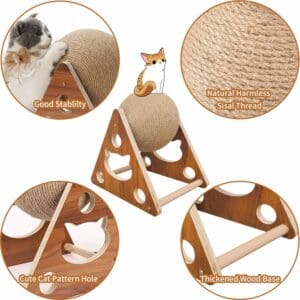Are you a proud new kitten owner? Congratulations! As you embark on this exciting journey, it’s important to understand the various stages of kitten development and the milestones you can expect your furry friend to reach. From their first steps to their adorable playtime antics, these milestones provide valuable insight into your kitten’s growth and well-being. By being aware of these stages, you can better nurture your kitten’s development and provide the care they need to thrive. So, let’s explore the fascinating world of kitten development and discover the incredible milestones you should watch out for.
Birth to Two Weeks
Physical Appearance
During the first two weeks of a kitten’s life, they are born with their eyes closed and their ears folded. Their body is small and delicate, covered in a soft coat of fur. The kittens rely on their mother for warmth and feeding, staying close to her at all times.
Motor Skills
At this stage, the kittens are still developing their motor skills. They are not yet able to walk or stand on their own, relying on their mother to move them around. Their movements are limited to crawling and wiggling, gradually gaining strength and coordination as the weeks progress.
Sense Development
Kittens’ senses start to develop during their first two weeks. Although their eyes are closed, they can sense light and shadows. Their sense of touch is highly sensitive, allowing them to feel their mother’s warmth and comforting presence. They rely on their sense of smell to locate their mother and find the source of nourishment.
Feeding
During this stage, the kittens solely depend on their mother’s milk for nourishment. It provides them with essential nutrients for healthy growth and development. The mother cat instinctively nurses her kittens, ensuring they receive the proper nourishment they need to thrive.
Elimination
The mother cat stimulates her kittens to eliminate waste by licking their hindquarters. At this stage, the kittens cannot control their bladder or bowel movements independently. The mother cat plays a crucial role in keeping them clean and assisting in the elimination process.
Sleep Patterns
Newborn kittens spend most of their time sleeping, with short bursts of wakefulness for feeding and basic movements. They sleep in close proximity to their mother, feeling secure and warm. As they grow, their sleep patterns adjust, gradually decreasing the amount of sleep and increasing periods of wakefulness.
Two to Four Weeks
Physical Growth
During the second to fourth weeks, kittens undergo rapid physical growth. They gain weight and their bodies begin to lengthen. Their eyes start to open, revealing their stunning eye color. Ears also start to unfold, allowing them to explore sounds in their environment.
Exploration
As their senses develop, kittens become more curious and start to explore their surroundings. They will begin to crawl and attempt to stand on wobbly legs. Their movement becomes more coordinated, allowing them to venture further from their mother.
Socialization
During this period, kittens start developing social skills. They interact with their littermates, engaging in playful behaviors such as pouncing and wrestling. These interactions help them learn important social cues and boundaries.
Starting Solid Food
Around three to four weeks, kittens start to show interest in solid food. This is an important milestone as they begin to transition from solely relying on their mother’s milk. Soft, moistened kitten food can be introduced during this stage, providing them with additional nutrients.
Litter Box Training
As the kittens start to eat solid food, they also begin to learn about toileting habits. The mother cat teaches them to use a litter box by gently guiding them and helping them understand the concept. It is important to provide a clean and accessible litter box to facilitate training.
Four to Eight Weeks
Playing and Interaction
During the four to eight-week stage, kittens become more active and playful. They engage in chasing, climbing, and wrestling with their littermates. Playtime provides mental and physical stimulation, helping them develop coordination, agility, and social skills.
Increased Independence
As kittens grow, they start to become more independent from their mother. They rely less on her for nourishment and begin exploring their environment on their own. They become more adventurous, venturing further from the safety of their mother’s presence.
Weaning from Mother’s Milk
Around five to six weeks, kittens are typically fully weaned from their mother’s milk. They transition to eating solid food exclusively, becoming less reliant on their mother for nourishment. It is important to monitor their diet during this transition to ensure they are getting all the necessary nutrients.
Introduction to Wet and Dry Foods
As the kittens become fully weaned, wet and dry kitten food can be introduced to their diet. Wet food provides hydration, while dry food helps in the development of their teeth and jaw strength. A balanced diet is crucial for their growth and overall health.
Beginnings of Self-Grooming
During this stage, kittens start to develop the instinct to groom themselves. They observe their mother’s grooming behavior and mimic it. They begin to use their tongues to clean their fur and learn the importance of maintaining good hygiene.
Eight to Twelve Weeks
Physical Development
Between eight to twelve weeks, kittens experience significant physical development. They grow rapidly in size and strength, and their coordination improves. Their facial features become more defined, and they start resembling miniature versions of adult cats.
Heightened Curiosity
As the kittens continue to grow, their curiosity becomes more intense. They explore their surroundings with increased enthusiasm, investigating every nook and cranny. This curiosity helps them learn about their environment and develop problem-solving skills.
Learning Basic Behavior
During this stage, kittens start learning basic behaviors, such as using a scratching post and understanding simple commands. Positive reinforcement and gentle guidance can aid in teaching them desirable behaviors and setting boundaries.
Full Weaning from Mother
By twelve weeks, kittens are fully weaned and no longer rely on their mother’s milk for nourishment. They have transitioned to a diet of wet and dry food, providing them with the necessary nutrients for their continued growth.
Introduction to Regular Feeding Schedule
At this stage, kittens benefit from having a regular feeding schedule. This helps establish healthy eating habits and prevents overfeeding or underfeeding. Providing meals at consistent times ensures they receive the necessary nutrition without excessive weight gain.
Three to Six Months
Rapid Growth
During the three to six-month stage, kittens continue to experience rapid growth, although at a slightly slower pace. They gain weight and their bodies lengthen, gradually transforming into young adult cats. Adequate nutrition is crucial during this phase to support their growth.
Active Play
Kittens at this age are full of energy and engage in active play. They chase toys, climb, and explore their environment with great enthusiasm. Playtime is not only fun for them but also essential for their physical and mental development.
Development of Permanent Teeth
Around three to four months, kittens start losing their baby teeth and growing their permanent teeth. This can cause discomfort, and they may chew on objects to alleviate the discomfort. Providing appropriate chew toys can help relieve their teething pain.
Establishing Territory
As kittens grow, they begin to establish their territory and mark their scent. They may exhibit territorial behaviors such as scratching, rubbing against objects, and urine spraying. Providing them with scratching posts and suitable surfaces for marking can redirect these behaviors.
Understanding Commands
By six months, kittens are capable of understanding basic commands such as “sit” or “come here.” Consistent training and positive reinforcement can help them learn these commands effectively. This lays the foundation for more advanced training in the future.
Six to Nine Months
Sexual Maturity
Between six to nine months, kittens reach sexual maturity. Unneutered males may display territorial and aggressive behaviors, while unspayed females may go into heat. Discussing spaying or neutering with a veterinarian is essential to prevent unwanted behaviors and ensure their well-being.
Transition to Adult Food
As kittens mature, they transition from kitten food to adult cat food. Adult food is formulated to meet their specific nutritional needs, and it is important to provide a balanced diet to support their growth and maintain their health.
Establishing Independence
At this stage, kittens become more independent and self-reliant. They may seek less attention from their human caregivers and prefer exploring and playing on their own terms. It is important to respect their need for independence while still providing love and care.
Advanced Training
With their increased maturity and ability to understand commands, more advanced training can be introduced. Kittens can learn tricks, further obedience training, and become acclimated to harnesses and leashes for outdoor adventures.
Preventing Unwanted Behaviors
During this stage, it is important to address any unwanted behaviors promptly. Clear communication, positive reinforcement, and redirection can help prevent and correct behaviors such as scratching furniture or aggressive play.
Nine to Twelve Months
Physical Maturity
Between nine to twelve months, kittens reach physical maturity. They have reached their full size and weight, resembling adult cats. Their skeletal and muscular development is complete, and they are ready to embrace adulthood.
Reproductive Capacity
By nine to twelve months, unspayed females may go into heat and become capable of reproducing. It is important to discuss spaying or breeding options with a veterinarian to prevent unwanted litters and ensure the cat’s overall health.
Transition to Adult Cat
At this stage, kittens are officially considered adult cats. They have transitioned from playful, mischievous kittens to more composed and mature individuals. Their personalities and behaviors are more settled.
Complete Basic Training
By twelve months, kittens should have completed their basic training. They should be well-versed in essential commands and have an understanding of acceptable behavior. Continued reinforcement and training can help further fine-tune their skills.
Continuous Socialization
Socialization is an ongoing process that should be continued throughout a cat’s life. Even at this stage, adult cats can benefit from positive interactions with humans, other animals, and varied environments. This helps them remain social, adaptable, and well-adjusted.
One to Two Years
Reaching Full Size
At one to two years, cats have reached their full size and weight. They have grown into the magnificent creatures they were destined to become. It is essential to monitor their weight to ensure they maintain a healthy physique.
Maturity in Behavior
As cats reach this stage, they become more settled and their behavior matures. They may display a more calm and composed demeanor compared to their playful kitten years. However, every cat is unique, and personalities can vary.
Evaluation of Health
Regular evaluations of the cat’s health are crucial during this stage. Annual check-ups with a veterinarian can help identify any potential health issues early on and ensure all preventative measures are taken to maintain their well-being.
Ongoing Preventative Care
Preventative care, such as vaccinations, deworming, and flea prevention, should be continued at this stage. These measures help protect the cat from common diseases and parasites, ensuring their long and healthy life.
Maintaining Mental Stimulation
Keeping an adult cat mentally stimulated is important for their overall well-being. Providing interactive toys, scratching posts, and puzzle feeders can help keep their minds sharp and prevent boredom or destructive behaviors.
Two to Four Years
Prime Adult Stage
Between two to four years, cats are considered to be in their prime adult stage. They have fully matured both physically and mentally. Their behavior is relatively stable, and they have settled into their adult personality.
Stabilized Behavior
Adult cats have established their behavior patterns and preferences. They may have specific likes, dislikes, and routines. Understanding and respecting their individuality is essential to maintaining a harmonious relationship.
Annual Veterinary Check-ups
Even though adult cats may appear healthy, it is important to continue with annual veterinary check-ups. These visits allow the veterinarian to monitor their overall health, provide necessary vaccinations, and address any concerns.
Nutritional Adjustments
As cats age, their nutritional needs may change. Adjusting their diet to meet their specific requirements is important for maintaining their health. Consulting with a veterinarian can help determine the appropriate diet for an adult cat’s needs.
Appropriate Exercise Levels
Adult cats require regular exercise to keep them physically fit and mentally stimulated. Interactive play sessions, climbing structures, and access to safe outdoor areas can help provide the necessary exercise and stimulation.
Four Years and Beyond
Senior Cat Stage
Around the age of four, cats enter their senior stage. They have aged gracefully and have likely become a cherished member of the family. It is important to provide them with extra care and attention during this stage of their life.
Specialized Senior Diets
Senior cats may require specialized diets to address their changing nutritional needs. These diets are designed to support their aging bodies and prevent common health issues that may arise in older cats.
Regular Health Monitoring
Regular health monitoring becomes even more important in the senior stage. Frequent visits to the veterinarian can help detect age-related health issues such as arthritis, dental disease, or kidney problems. Early detection can greatly improve the quality of life for senior cats.
Creating a Comfortable Environment
Senior cats benefit from a comfortable and stress-free living environment. Providing cozy beds, easy access to food and water, and a warm, quiet space can help them navigate their golden years with comfort and ease.
Quality of Life Factors
As cats age, their quality of life becomes a key consideration. Ensuring they have regular companionship, veterinary care, appropriate pain management, and a loving environment all contribute to their overall well-being and happiness.
In conclusion, understanding the different stages of kitten development is essential for providing appropriate care and guidance. From their birth to their senior years, each stage brings unique milestones and challenges. By being knowledgeable and attentive, you can ensure that your feline companion enjoys a happy, healthy, and fulfilling life throughout their journey.







